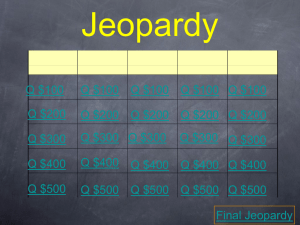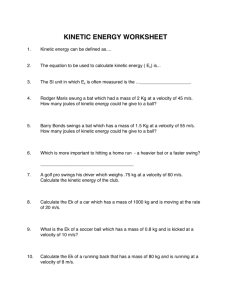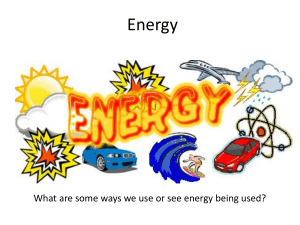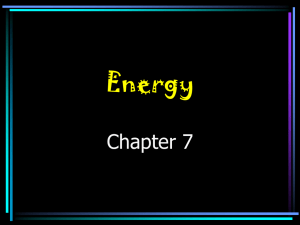Work, Power and Energy Worksheet
advertisement
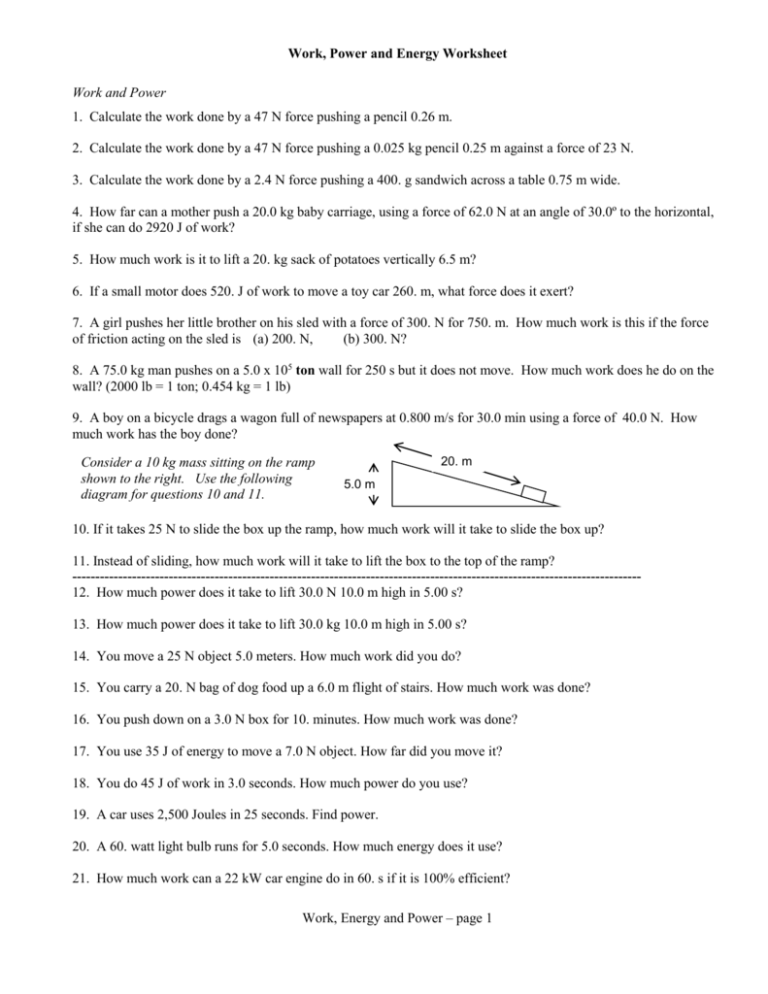
Work, Power and Energy Worksheet Work and Power 1. Calculate the work done by a 47 N force pushing a pencil 0.26 m. 2. Calculate the work done by a 47 N force pushing a 0.025 kg pencil 0.25 m against a force of 23 N. 3. Calculate the work done by a 2.4 N force pushing a 400. g sandwich across a table 0.75 m wide. 4. How far can a mother push a 20.0 kg baby carriage, using a force of 62.0 N at an angle of 30.0º to the horizontal, if she can do 2920 J of work? 5. How much work is it to lift a 20. kg sack of potatoes vertically 6.5 m? 6. If a small motor does 520. J of work to move a toy car 260. m, what force does it exert? 7. A girl pushes her little brother on his sled with a force of 300. N for 750. m. How much work is this if the force of friction acting on the sled is (a) 200. N, (b) 300. N? 8. A 75.0 kg man pushes on a 5.0 x 105 ton wall for 250 s but it does not move. How much work does he do on the wall? (2000 lb = 1 ton; 0.454 kg = 1 lb) 9. A boy on a bicycle drags a wagon full of newspapers at 0.800 m/s for 30.0 min using a force of 40.0 N. How much work has the boy done? Consider a 10 kg mass sitting on the ramp shown to the right. Use the following diagram for questions 10 and 11. 20. m 5.0 m 10. If it takes 25 N to slide the box up the ramp, how much work will it take to slide the box up? 11. Instead of sliding, how much work will it take to lift the box to the top of the ramp? ---------------------------------------------------------------------------------------------------------------------------12. How much power does it take to lift 30.0 N 10.0 m high in 5.00 s? 13. How much power does it take to lift 30.0 kg 10.0 m high in 5.00 s? 14. You move a 25 N object 5.0 meters. How much work did you do? 15. You carry a 20. N bag of dog food up a 6.0 m flight of stairs. How much work was done? 16. You push down on a 3.0 N box for 10. minutes. How much work was done? 17. You use 35 J of energy to move a 7.0 N object. How far did you move it? 18. You do 45 J of work in 3.0 seconds. How much power do you use? 19. A car uses 2,500 Joules in 25 seconds. Find power. 20. A 60. watt light bulb runs for 5.0 seconds. How much energy does it use? 21. How much work can a 22 kW car engine do in 60. s if it is 100% efficient? Work, Energy and Power – page 1 22. A force of 5.0 N moves a 6.0 kg object along a rough floor at a constant speed of 2.5 m/s. (a) How much work is done in 25 s? (b) What power is being used? (c) What force of friction is acting on the object? 23. How much electrical energy (in kilowatt-hours) would a 60.0 W light bulb use in 60.0 days if left on steadily? 24. A power mower does 9.00 x 105 J of work in 0.500 h. What power does it develop? 25. How long would it take a 500. W electric motor to do 1.50 x 105 J of work? Kinetic Energy and Potential Energy 1. What is the gravitational potential energy of a 61.2 kg person standing on the roof of a 10-story building relative to (a) the tenth floor, (b) the sixth floor, (c) the first floor? (Each story is 2.50 m high.) 2. A 1.00 x 104 kg airplane lands, descending a vertical distance of 10.0 km while travelling 100. km measured along the ground. What is the plane's loss of potential energy? 3. Calculate the kinetic energy of a 45 gram golf ball travelling at: (a) 20. m/s, (b) 40. m/s, (c) 60. m/s. 4. How fast must a 1000. kg car be moving to have a kinetic energy of: (a) 2.0 x 103 J, (b) 2.0 x 105 J, (c) 1.0 kWh? 5. A coconut falls out of a tree 12.0 m above the ground and hits a bystander 3.00 m tall on the top of the head. It bounces back up 1.50 m before falling to the ground. If the mass of the coconut is 2.00 kg, calculate the potential energy of the coconut relative to the ground at each of the following sites: (a) while it is still in the tree, (b) when it hits the bystander on the head, (c) when it bounces up to its maximum height, (d) when it lands on the ground, (e) when it rolls into a groundhog hole, and falls 2.50 m to the bottom of the hole. 6. A 50.0 kg bicyclist on a 10.0 kg bicycle speeds up from 5.00 m/s to 10.0 m/s. (a) What was the total kinetic energy before accelerating? (b) What was the total kinetic energy after accelerating? (c) How much work was done to increase the kinetic energy of the bicyclist? (d) Is it more work to speed up from 0 to 5.00 m/s than from 5.00 to 10.0 m/s? 7. How high would you have to lift a 1000. kg car to give it a potential energy of: (a) 2.0 x 103 J, (b) 2.00 x 105 J, (c) 1.00 kWh? 8. Calculate the potential energy of a 5.00 kg object sitting on a 3.00 meter high ledge. 9. A 10.0 kg rock is at the top of a 20.0 m. tall hill. How much potential energy does it have? 10. A 25 N object is 3.0 meters up. How much potential energy does it have? 11. How high up is a 3.00 kg object that has 300. J of energy? 12. A 4.00 kg rock is rolling 10.0 m/s. Find its kinetic energy. 13. An 8.0 kg cat is running 4.0 m/s. How much kinetic energy does it have? Work, Energy and Power – page 2 14. At the moment when a shotputter releases a 5.00 kg shot, the shot is 3.00 m above the ground and travelling at 15.0 m/s. It reaches a maximum height of 14.5 m above the ground and then falls to the ground. If air resistance is negligible, (a) What was the potential energy of the shot as it left the hand relative to the ground? (b) What was the kinetic energy of the shot as it left the hand? (c) What was the total energy of the shot as it left the hand? (d) What was the total energy of the shot as it reached its maximum height? (e) What was the potential energy of the shot at its maximum height? (f) What was the kinetic energy of the shot at its maximum height? (g) What was the kinetic energy of the shot just as it struck the ground? 15. A rolling ball has 18 J of kinetic energy and is rolling 3.0 m/s. Find its mass. 16. A 4.0 kg bird has 8.0 J of kinetic energy. How fast is it flying? 17. A rubber band is stretched from its resting position a distance of 0.10 m. If the spring constant is 2.5 N/m, what is the force exerted on the rubber band? 18. A 12 V car battery is found to be capable of storing 2.00 kWh of electrical energy. For a certain electric car, it is necessary to develop 1.00 x 104 W of power to drive at 5.56 m/s. (a) Suppose that the car has 10 such batteries which results in 10 times the energy. How long (in hours) could it run if all 10 of them released all of their energy? (b) How far (in kilometers) can the car go on its 10 batteries if they are fully charged? 19. If a spring is stretched a distance of 0.25 m with a force of 20. N, what is the value of the spring constant? 20. If the spring constant of a pogo stick is 3500. N/m and the weight of the person on the pogo stick is 700. N, how much is the spring in the bottom of the pogo stick compressed? 21. A 20.0 kg cart on wheels has been pushed up against a wall with a spring (k = 244 N/m) between the wall and the cart. The spring is compressed a distance of 0.100 m. (a) What is the force of the spring on the cart? (b) If an applied force of 20.0 N is applied toward the wall, what will the acceleration of the cart be? 22. A box having a mass of 1.50 kg is accelerated across a table at 1.50 m/s2. The coefficient of friction on the box is 0.300. (a) What is the force being applied to the box? (Use: Fapp -fs = ma) (b) If this force were applied by a spring, what would the spring constant have to be in order for the spring to be stretched to only 0.0800 m while pulling the box? 23. A spring (k = 2.3 N/m) is attached to an object of mass = 10. kg. If the object is hung from the ceiling by this spring, how much would the spring be stretched? 24. If s =0.50, how much force must be applied to a spring (spring constant of 0.80 N/m) which is attached to a block of wood (mass = 4.0 kg) in order to just begin to move the block? (Use: Fapp - fs = ma; Recall that f = µFN) 25. A 3.0 kg metal ball, at rest, is hit by a 1.0 kg metal ball moving at 4.0 m/s. The 3.0 kg ball moves forward at 2.0 m/s and the 1.0 kg ball bounces back at 2.0 m/s. (a) What is the total kinetic energy before the collision? (b) What is the total kinetic energy after the collision? (c) How much energy is transferred from the small ball to the large ball? 26. When a 50.0 kg person hangs from a 20.0 m bungee cord it stretches to a length of 32.0 m. (a) Find the spring constant of the bungee cord, assuming it obeys Hooke's law. Work, Energy and Power – page 3 26. (b) How much work is required to stretch the cord by this much? 27. A spring with a force constant of 5.20 N/m has a relaxed length of 2.45 m. When a mass is attached to the end of the spring and allowed to come to rest, the vertical length of the spring is 3.57 m. Calculate the elastic potential energy stored in the spring. 28. The staples inside a stapler are kept in place by a spring with a relaxed length of 0.115 m. If the spring constant is 51.0 N/m, how much elastic potential energy is store in the spring when its length is 0.150 m? 29. A 6.0 kg metal ball moving at 4.0 m/s hits a 6.0 kg ball of putty at rest and sticks to it. The two go on at 2.0 m/s. (a) What is the kinetic energy of the metal ball before it hits? (b) What is the kinetic energy of the metal ball after it hits? (c) What is the kinetic energy of the putty ball after being hit? (d) How much energy does the metal ball lose in the collision? (e) How much kinetic energy does the putty ball gain in the collision? (f) What happened to the rest of the energy? Conservation of Energy 1. A 10. kg ball is thrown into the air. It is going 3.0 m/s when thrown. How much potential energy will it have at the top? 2. A 4768-kg roller coaster train full of riders approaches the loading dock at a speed of 17.1 m/s. It is abruptly decelerated to a speed of 2.20 m/s over a distance of 13.6 m. Determine the magnitude of the retarding force which acts upon the roller coaster cars. 3. A 4.00 kg ball is on a 5.00 m ledge. If it is pushed off the ledge, how much kinetic energy will it have just before hitting the ground? 4. A 25 kg ball is thrown into the air. When thrown it is going 10. m/s. Calculate how high it travels. 5. A 3.0 kg rock sits on a 0.80 meter ledge. If it is pushed off, how fast will it be going at the bottom? 6. A catcher's mitt recoils a distance of 12.9 cm in bringing a 142-gram baseball to a stop. If the applied force is 588 N, then what was the speed of the baseball at the moment of contact with the mitt? 7. An unknown force is applied to a 12 kg mass. The force acts at an angle of 30.0 degrees above the horizontal. Determine the force acting if the force acts for a horizontal displacement of 22 meters and increases the 12 kg mass's speed from 11 m/s to 26 m/s. 8. A physics teacher exerts a force upon a 3.29-kg pile of snow to both lift it and set it into motion. The snow leaves the shovel with a speed of 2.94 m/s at a height of 0.562 m. Determine the work done upon the pile of snow. 9. A 250.-gram cart starts from rest and rolls down an inclined plane from a height of 0.541 m. Determine its speed at a height of 0.127 m above the bottom of the incline. 10. A 4357-kg roller coaster car starts from rest at the top of a 36.5-m high track. Determine the speed of the car at the top of a loop that is 10.8 m high. 11. While on the moon, the Apollo astronauts enjoyed the effects of a small gravity. If Neil Armstrong jumped up on the moon with an initial speed of 1.51 m/s to a height of 0.700 m, what amount of gravitational acceleration did he experience? Work, Energy and Power – page 4 12. In a wild shot, Bo flings a pool ball of mass m off a 0.68 m high pool table, and the ball hits the floor with a speed of 6.0 m/s. How fast was the ball moving when it left the table? 13. A 500.0 kg pig is standing at the top of a muddy hill on a rainy day. The hill is 100.0 m long with a vertical drop of 30.0 m. The pig slips and begins to slide down the hill. What is the pig’s speed at the bottom of the hill? 14. A 50.0 kg gorilla is sitting on the limb of a tree 4.00 meters above the ground. The gorilla jumps down from the tree limb to the ground. Use the conservation of energy to find the velocity of the gorilla just before hitting the ground. 15. A 2.00 kg ball is dropped from the top of a 10.0 m high building. Calculate the potential AND kinetic energies at: (a) 10.0 m (b) 8.00 m (c) 5.00 m (d) 0.00 m. 16. A 10.0 g pebble is placed in a sling shot with a spring constant of 200.0 N/m and is stretched back 0.500 m. What is the maximum velocity the pebble will acquire? 17. A 0.0340 kg bullet traveling at 120. m/s embeds itself in a 1.24 kg wooden block which is at rest on a smooth surface. The block then slides toward a spring and collides with it. The block compresses the spring (k = 99.0 N/m). Calculate how far the block-bullet compresses the spring. Work and Power 1) 12 J 6) 2.00 N 10) 5.0 x 102 J 15) 120 J 20) 3.0 x 102 J 23) 86.4 kWh 2) 6.0 J 7a) 7.50 x 104 J 11) 490 J 16) 0 21) 1.3 x 106 J 24) 500. W Kinetic Energy and Potential Energy 1a) 1.50 x 103 J 1b) 7.50 x 103 J 3b) 36 J 3c) 81 J 5a) 235 J 5b) 58.8 J 6a) 750 J 6b) 3.00 x 103 J 7b) 20.4 m 7c) 367 m 11) 10.2 m 12) 200. J 14c) 710. J 14d) 710. J 15) 4.0 kg 16) 2.0 m/s 19) 80. N/m 20) – 0.200 m 22b) 83.3 N/m 23) 43 m 25c) 6.0 J 26a) 40.8 N/m 29a) 48 J 29b) 12 J 29f) friction and deformation of objects Conservation of Energy 1) 45 J 2) – 50500 N 6) 32.7 m/s 7) 180 N 11) – 1.63 m/s2 12) 4.8 m/s 15a) PE = 196 J, KE = 0 J 15d) PE = 0 J, KE = 196 J 3) 1.8 J 7b) 0 12) 60.0 W 17) 5.0 m 22a) 310 J 25) 300. s 4) 54.4 m 8) 0 13) 588 W 18) 15 W 22b) 12 W 5) 1300J 9) 57600 J 14) 130 J 19) 100. W 22c) 5.0 N 1c) 1.50 x 104 J 4a) 2.0 m/s 5c) 88.2 J 6c) 2250 J 8) 147 J 13) 64 J 14e) 710. J 17) – 0.25 N 21a) 24.4 N 24) 20. N 26b) 2940 J 29c) 12 J 2) 9.80 x 108 J 4b) 20. m/s 5d) 0 6d) no 9) 1960 J 14a) 147 J 14f) 0 18a) 2.0 h 21b) 0.220 m/s2 25a) 8.0 J 27) 3.26 J 29d) – 36 J 3a) 9.0 J 4c) 85 m/s 5e) – 49 J 7a) 0.20 m 10) 75 J 14b) 563 J 14g) 710. J 18b) 40.0 km 22a) 6.66 N 25b) 8.0 J 28) 0.0312 J 29e) 12 J 3) 196 J 8) 32.3 J 13) 24.2 m/s 15b) PE = 157 J, KE = 39 J 16) 70.7 m/s 4) 5.1 m 5) 4.0 m/s 9) 2.85 m/s 10) 22.4 m/s 14) 8.85 m/s 15c) PE = 98.0 J, KE = 98.0 J 17) 0.363 m Work, Energy and Power – page 5

